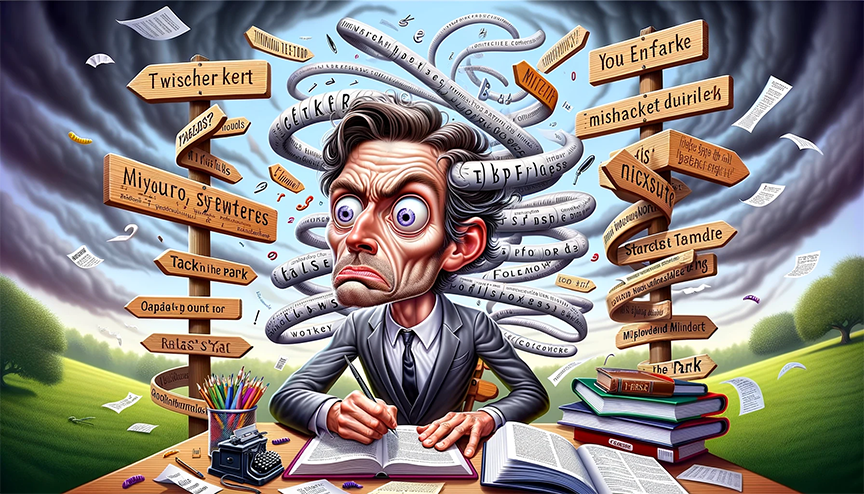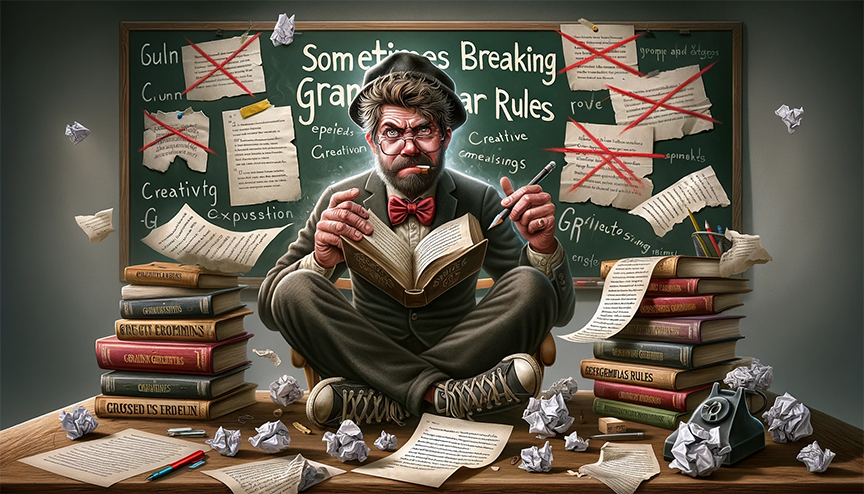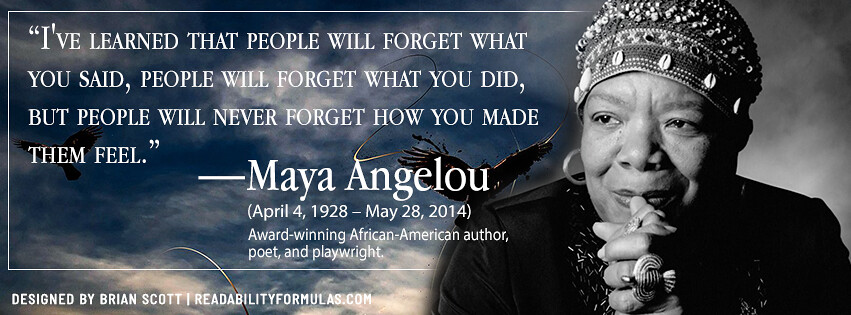 In the vibrant, fast-paced city of New York, an ambitious writer named Mia had recently launched a lifestyle blog; she hoped to turn her passion for writing into a successful online venture. She was brimming with ideas. She often found herself typing away late into the night, eager to share her latest musings with her growing audience.
In the vibrant, fast-paced city of New York, an ambitious writer named Mia had recently launched a lifestyle blog; she hoped to turn her passion for writing into a successful online venture. She was brimming with ideas. She often found herself typing away late into the night, eager to share her latest musings with her growing audience.
One evening she decided to write about a new art exhibit in town. She quickly composed an article, infusing it with her enthusiasm. Without pausing to proofread, Mia excitedly hit the ‘publish’ button–her words were now live for the world to see.
The next day, Mia was taken aback by the mixed reactions in the comments section. Many readers praised her insights, but a few pointed out grammatical errors and misused words. One comment caught her eye–it was from a former English teacher, Mrs. Evans, who had always encouraged Mia’s writing in high school.
Mrs. Evans had written a thoughtful note, reminding Mia about her attention to detail. She pointed out the mix-ups between “its” and “it’s,” and “affect” and “effect,” among other errors. While Mia’s content was engaging, Mrs. Evans gently explained that such common errors detracted from the professionalism and credibility of her work.
Feeling embarrassed yet grateful, Mia revisited her post, correcting the mistakes. She acknowledged her oversight in a brief post to her readers. From that day on, Mia adopted a new writing process based on tips from her teacher.
Mia shares her tips below:
Don’t trust your spell checker. No automated spell-checker can alert you to every error. Whose and who’s, lose and loose, quiet and quite, its and it’s are all legitimate words, but your spell checker won’t underscore them in red as potential style usage errors. Spell-checkers are not clever enough yet to tell which word you meant to use. And if the error is not due to a typo, it means you need to consult Google or a dictionary to check any uncertainties.
Whose vs. Who’s
- “I wrote ‘whose’ in my essay, and my spell checker was fine with it. It’s a shame it didn’t know who’s actually going to read this–my English teacher!”
Lose vs. Loose
- “I typed ‘I hope I don’t loose my keys’ into a document. My spell checker didn’t bat an eye. Guess it’s too loose with its rules!”
Quiet vs. Quite
- “My spell checker didn’t correct ‘The library is quite today.’ Clearly, it’s not quiet about letting mistakes slide!”
Its vs. It’s
- “I wrote ‘its going to rain’ and my spell checker approved. It’s not raining confidence in its abilities, that’s for sure!”
Remember using a word ending in ‘s means a letter is missing. “It’s” means “it is.” If you are unsure which one to use, try saying the sentence both ways.
For instance…
“It’s a good day today / It is a good day today.” The latter example makes perfect sense, so it is okay to use “it’s.”
But….
“Here is a rabbit. Its burrow is over there.” Does, “It is burrow is over there” make sense? Not!
Of course if you said, “The rabbit’s burrow is over there,” then the apostrophe denotes possession (and only one rabbit), not a missing letter. “The rabbits burrow is over there,” (with no apostrophe) means there are several rabbits.
For the record, “loose” means not tight, while “lose” means you’ve lost it.
“Who’s” is short for “who is,” but “whose” is the possessive form of “who” (as in “Whose is that car?“) .
“Quiet” means “hush“, while “quite” is an adverb (which should usually be left out).
“I felt quite silly,” sounds better as, “I felt silly.” “I felt like an idiot,” may be even better.
Writing isn’t a walk in the park, and as diligent wordsmiths, we must be ever watchful of these troublesome mix-ups:
- “Your” vs. “You’re”: “Your” shows possession, like “Your book is on the table.” “You’re” is a contraction for “you are.” Remember, if you can replace it with “you are,” then “you’re” is your winner.
- “Affect” vs. “Effect”: This one can baffle even seasoned writers. “Affect” is typically a verb meaning to influence, while “Effect” is a noun meaning the result. For instance, “The rain did not affect my mood” versus “The effect of the rain was negligible.”
- “Fewer” vs. “Less”: If you can count it, use “fewer.” If you can’t, use “less.” So you’d say “fewer coins” but “less money.” It’s a subtle difference that can make your writing shine.
- Semicolons, Colons, Dashes, and Hyphens: These tiny marks can create big trouble. A semicolon connects closely related ideas; a colon introduces a list or explanation. Dashes set off information—like this—while hyphens connect words like “well-known.”
- Passive vs. Active Voice: The passive voice can make your writing seem weak and indirect. Compare “The ball was thrown by John” to “John threw the ball.” The latter is more concise and engaging, wouldn’t you agree?
- Ending Sentences with Prepositions (Again): It’s still a myth, and it bears repeating. You can end sentences with prepositions if it sounds natural. “What are you looking for?” is perfectly fine, and anything else might sound overly formal.
Of course, these aren’t hard and fast rules for every situation. Language is a living, breathing entity, and it’s not always confined by strict laws. If you feel an urge to bend these rules creatively in your writing, go ahead—but with caution and awareness.
Sometimes rules of grammar inhibit good writing. If this is the case, feel free to break the rules, otherwise your writing will become pedantic and mechanical. One such rule is you should not begin a sentence with a conjunction. You can use both “and” and “but” to begin a sentence, or even a paragraph, but not to end one. Starting a sentence with either of these conjunctions can be a natural transition to carry the reader forward.
- “The sky was clear and blue. And in that vast expanse, a lone eagle soared majestically.”
- “He had always been afraid of heights. But today, he stood at the edge of the cliff, ready to leap.”
- “You can stay in and read a book. Or, you could join us for a walk in the park.”
- “He decided to postpone the meeting. For he needed more time to gather essential information.”
A rule of style tells us to never use the same word twice in a sentence; but if you have to search for several other clumsy substitutes to do the job, then please repeat. Repetition of someone’s name is a little different. You can easily replace it with “he” or “she” as the sentence progresses.
Avoiding Clumsy Substitutes:
- Original: “The painting captured the painting’s essence beautifully, making the painting a highlight of the exhibit.”
- Revised: “The painting captured its essence beautifully, making it a highlight of the exhibit.”
- Reason: In this revision, ‘its’ and ‘it’ replace repetitive mentions of ‘the painting’, making the sentence more fluid.
Repetition vs. Pronouns:
- Original: “Sarah admired Sarah’s favorite artwork, and Sarah discussed Sarah’s interpretation with the guide.”
- Revised: “Sarah admired her favorite artwork and discussed her interpretation with the guide.”
- Reason: Using ‘her’ instead of repeating ‘Sarah’ simplifies the sentence and keeps the focus on the art.
When Repetition is Preferable:
- Clumsy Substitute: “The artist created the sculpture, and then the creator explained the concept to the audience.”
- Better with Repetition: “The artist created the sculpture, and then the artist explained the concept to the audience.”
- Reason: Repeating ‘the artist’ avoids confusion about who ‘the creator’ is, ensuring clarity for the readers.
Pronoun Ambiguity:
- Original: “Alex told Jordan they were impressed by the installation.”
- Ambiguous: Who is ‘they’? Alex or Jordan?
- Clarified: “Alex told Jordan, ‘I am impressed by the installation.'”
- Reason: Using direct speech removes ambiguity about who was impressed.
A persistent myth posing as a rule tells us not to end a sentence with a preposition. Winston Churchill made fun of this by stating, “This is the sort of English up with which I will not put.” Of course a sentence may end with a preposition. A good rule is to write the way you speak. But unless you have grown up speaking English, ignore this rule too.
The Art of Storytelling
The written word is not merely a collection of facts and rules; it’s an artistic canvas where creativity thrives. Great storytelling breathes life into the most mundane subjects, making them resonate with readers. Here’s how you can infuse storytelling into your work:
- The Hook: Remember the best stories you’ve ever read? They probably grabbed your attention right from the first sentence. Begin your article with an interesting hook—a question, a quote, or a startling fact—that ignites curiosity. For instance, “Have you ever wondered why the sky is blue?” is more intriguing than simply stating facts about light scattering.
- Use Anecdotes and Metaphors: Don’t shy away from painting vivid images with words. Share a personal anecdote, draw a metaphor, or weave a simile into your writing. Saying “Life is like a box of chocolates; you never know what you’re going to get” is not just poetic but also relatable.
- Build a Narrative Arc: Even an informational article can have a beginning, middle, and end. Introduce the subject, explore the complexities, and conclude with a satisfying resolution. Treat your article like a short story where the subject matter is the hero, going on a journey of discovery.
- Show, Don’t Just Tell: This age-old wisdom still rings true. Instead of simply stating facts, show them in action. If you’re writing about perseverance, tell a tale of someone who overcame tremendous odds. Let the story do the talking.
- Consider Your Audience: Who are you telling this story to? Knowing your audience helps you choose the right tone, style, and content. If you’re writing for children, for example, your storytelling might be more whimsical and imaginative.
- Break the Rules (Wisely): Just as in grammar, there are rules in storytelling. And just as in grammar, sometimes breaking them can lead to unique and expressive writing. But tread carefully; breaking rules without understanding them might lead to confusion rather than creativity.
The art of storytelling is a powerful tool. It turns a dry, factual piece into a living, breathing entity that speaks to readers’ hearts and minds. It’s not about abandoning facts but about presenting them in a way that’s engaging, emotive, and memorable. After all, facts tell, but stories sell. So let your inner storyteller roam free, and watch as your articles transform from mere text into captivating narratives.
The Cultural Canvas of Language
Language is a mirror reflecting society, its values, its norms, and its intricacies. As writers, we must recognize that our words don’t exist in a vacuum. They speak to real people, with real backgrounds, in a real world teeming with diversity. Here’s how to navigate the complex landscape of cultural and contextual considerations:
- Know Your Audience: If you’re writing for a global audience, beware of idioms, slang, or references that might not translate well. What’s as clear as a bell to one reader might be Greek to another. Literally.
- Respect Cultural Sensitivities: A turn of phrase that’s considered humorous in one culture might be offensive in another. Approach cultural references with caution and empathy. After all, we’re not just writers; we’re global citizens.
- Embrace the Evolution of Language: Language is alive, and like anything alive, it grows and changes. Embrace the new words, expressions, and grammatical structures that evolve over time. The rule book is never set in stone.
- Consider the Platform and Context: Writing a formal report? Stick to the traditional rules. Penning a blog post for a youth-oriented website? Feel free to let your hair down a bit. Understanding where your writing will be published helps you tailor your language accordingly.
- Use Inclusive Language: Strive to be inclusive in your word choices. For instance, opt for ‘firefighter’ instead of ‘fireman,’ ‘server’ instead of ‘waitress.’ Small changes like these can make a big difference in how your writing resonates with readers.
- Don’t Stereotype or Generalize: Each culture is rich and multifaceted. Avoid clichés and stereotypes that reduce complex cultures to simplistic caricatures. Challenge yourself to explore the nuances.
- Stay Informed: The world is changing, and so are its cultural norms and language. Regularly read, explore different cultures, engage with diverse communities, and stay updated on the current trends and debates in language and culture.
The pen, they say, is mightier than the sword. But it can also be just as cutting if wielded without care and understanding. Remember, the words you choose and the way you frame them can either build bridges or erect walls. Embrace the richness of our global tapestry and use it to enrich your writing. In the end, being mindful of cultural and contextual considerations doesn’t limit creativity; it enhances it, creating a broader, more vibrant canvas upon which to paint your prose.
A few more pointers
1) Watch that you don’t repeat information unnecessarily. Even if you use different wording, it still impresses upon readers that you think they were too dumb to get it the first time.
2) Use short sentences more than long ones, but do vary the length. Use a free readability tool at ReadabilityFormulas.com to find out if your readers can read and understand your content.
3) Break up the text by using bullet points, or asking a question. Why? It adds interest. It prevent your reader from snoozing–or simply turning the page or skimming the screen.
4) Use short paragraphs too. This will make the job of reading (and self-editing) it all seem much easier. In this fast-paced world readers are mostly in a hurry. If they face a huge block of text with no white space, they’ll sigh and skip most of it.
“Examine every word…You’ll find a surprising number that don’t serve any purpose.” —William Zinsser, author of On Writing Well
If you keep these pointers in mind, your writing will be alive and thrive.










